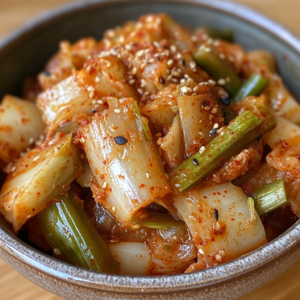Kimchi (김치): A Spicy, Tangy, and Iconic Korean Staple
Introduction
Few dishes are as synonymous with Korean cuisine as Kimchi (김치). This iconic fermented side dish, made from Napa cabbage, radishes, and other vegetables, is seasoned with a bold blend of garlic, ginger, and Korean red pepper flakes (gochugaru). It’s known for its unique, tangy, and spicy flavor, as well as its probiotic benefits. Whether enjoyed as a side dish, in soups, or as an ingredient in countless Korean recipes, kimchi adds a burst of flavor and complexity to any meal. Let’s explore why this fermented favorite has become a global sensation and how you can make your own delicious batch at home!
Why You’ll Love Kimchi
Bold and Flavorful: With its perfect balance of tanginess, spiciness, and umami, kimchi brings a punch of flavor to every dish it accompanies.
Healthy and Nutritious: Packed with probiotics from the fermentation process, kimchi is great for gut health. Plus, it’s low in calories and full of vitamins from the vegetables.
Versatile Ingredient: Kimchi is not just a side dish—it can be used in fried rice, stews, pancakes, and more. It’s a versatile ingredient that adds depth and complexity to many meals.
A Taste of Tradition: Kimchi is a fundamental part of Korean culture and cuisine. By making it at home, you can experience the time-honored tradition of fermenting vegetables with bold, delicious flavors.
From its tangy crunch to its countless health benefits, Kimchi is a beloved Korean staple that’s easy to make and even easier to enjoy. Whether you’re new to fermentation or a seasoned pro, this kimchi recipe will have you savoring every bite. Try it today and elevate your meals with a taste of Korea!
Kimchi Recipe (Napa Cabbage)
Ingredients:
1 medium Napa cabbage (about 2-3 lbs)
1/4 cup coarse sea salt (for salting cabbage)
1 cup water (for the salt brine)
For the Kimchi Paste:
1 tablespoon glutinous rice flour (optional, for a thicker paste)
1 cup water (for the rice paste)
3 tablespoons gochugaru (Korean red pepper flakes) – adjust to taste
3 tablespoons fish sauce (or soy sauce for vegan)
2 tablespoons soy sauce (optional for extra flavor)
1 tablespoon sugar (or honey)
4-5 garlic cloves, minced
1-inch piece of ginger, minced
3-4 green onions, chopped
1 small carrot, julienned (optional)
1 small daikon radish, julienned (optional)
Instructions:
Prepare the Cabbage:
Slice the Napa cabbage lengthwise into quarters. Cut out the core, then chop the cabbage into 2-inch pieces.
Place the cabbage in a large mixing bowl and sprinkle with 1/4 cup of coarse sea salt. Pour 1 cup of water over the cabbage and mix well.
Let the cabbage sit for 1-2 hours, turning occasionally to ensure even salting. The cabbage should soften and release moisture.
Rinse and Drain:
After 1-2 hours, rinse the cabbage thoroughly under cold water to remove excess salt. Drain well and set aside.
Make the Rice Paste (Optional):
In a small saucepan, mix 1 tablespoon of glutinous rice flour with 1 cup of water. Cook over medium heat, stirring continuously until the mixture thickens into a paste (about 3-5 minutes). Remove from heat and let it cool.
Prepare the Kimchi Paste:
In a bowl, combine the gochugaru (Korean red pepper flakes), fish sauce (or soy sauce), sugar, garlic, ginger, and the cooled rice paste (if using). Mix everything together to form a smooth paste.
Add the chopped green onions, carrot, and daikon radish to the paste and mix well.
Mix the Kimchi:
Gently massage the kimchi paste into the drained cabbage, ensuring all the cabbage pieces are evenly coated with the paste. Wear gloves if needed to avoid staining from the red pepper flakes.
Pack the Kimchi into Jars:
Pack the coated cabbage into clean glass jars or a container, pressing down firmly to remove any air bubbles. Leave about 1 inch of space at the top to allow for expansion as it ferments.
Seal the jar loosely to allow gases to escape during fermentation.
Ferment the Kimchi:
Leave the jar at room temperature for 1-2 days to ferment. The longer it ferments, the tangier it becomes. After 1-2 days, taste the kimchi, and when it’s to your liking, transfer it to the refrigerator to slow down the fermentation process.
Store and Enjoy:
Kimchi can be eaten immediately, but it’s best after it has fermented for at least a week. Store it in the fridge for up to 2-3 months.
Tips:
Vegan Option: Use soy sauce or tamari instead of fish sauce to make vegan kimchi.
Adjust the Spice Level: If you prefer a milder kimchi, reduce the amount of gochugaru, or for extra heat, add more.
Fermentation: Keep an eye on the jar during fermentation; some bubbles and liquid overflowing are normal as the kimchi ferments.
This traditional Kimchi recipe is versatile, flavorful, and packed with probiotics, making it a perfect side dish or ingredient for many Korean meals. Enjoy!


